|
Ploughing
|
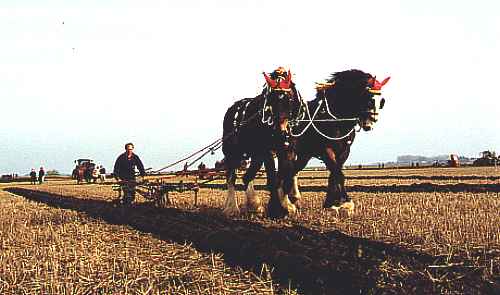
Farmer John Goodwin, the 1999 English ploughing champion, competing in the annual Deeping ploughing match at Deeping St Nicholas in October 1999 with his Shire horses Reggie and Blue. Reggie is the biggest working horse in England and John, aged 42, from the Isle of Sheppey in Kent, is a dedicated competitor in heavy horse ploughing matches and after winning his title at the national championships in
Oxfordshire, he hopes to compete in the world championships to be held in Lincolnshire in September 2000. |
The most familiar of all of the countryside
activities is ploughing. The mere act of tilling the soil and preparing the land for a new growing year lends itself to analogy and metaphor and so it has a long history of celebration in our folklore and religion, art and literature, poetry and song.
Who has not given full voice to Jane Montgomery Campbell's rousing hymn at harvest festival We plough the fields, and scatter, the good seed on the land or pondered on A E Housman's evocative lines in A Shropshire Lad "Is my team ploughing, that I was used to drive?"
Isaiah's biblical exhortation to warring tribes ". . . and they shall beat their swords into ploughshares, and their spears into pruning hooks" has become a cry to end all wars and for men to lay down their arms and return to more peaceable toil on the land while Benjamin Britten's captivating arrangement of the folksong The Plough Boy is still available on record more than fifty years after it was first published. The plough in astronomy is a popular name for the most prominent part of the constellation Ursa Major because of its close resemblance to a team at work turning the land and the Plough is among the most frequent of our public house signs associated with agriculture. Many ancient artefacts such as coins and vases from Greek and Roman times carry illustrations of early ploughs. Others are depicted in Saxon manuscripts and the Bayeux tapestry of 1067-70 and since then, paintings, prints and pottery have been used to show the rustic pleasures of the ploughman's life although reality was often rather different.
Several country customs celebrate this ubiquitous farming implement, the most popular being Plough Monday, the first Monday after Epiphany on January 6th and so called because it was formerly the day on which work on the farm was resumed after the Twelve Days of Christmas when the spring ploughing began. Thomas Tusser conjured up a picture of industrious ploughmen hard at work on countless farms at the beginning of the season when he wrote in 1580: "Plough Monday, next after that Twelfth tide is past, Bids out with the plough, the worst husband is last."
But how much actual work was ever done on this anniversary is very uncertain because, in England at least, the principal feature of the day was not ploughing but the ritual dragging of a decorated plough from door to door in the parish by bands of young men begging "plough money" to pay for the subsequent festivities. This custom, and variations of it, survive in some parts of the country although Plough Sunday services at the parish church have become a more popular observance in many agricultural districts during the past fifty years when a plough is brought into church by farmers and ploughmen "to offer the work of the countryside to the service of God".
All of this to immortalise the act of preparing the land for another growing cycle, another year's crop. The object of ploughing is to turn the top surface of the soil and bury surface plant growth and rubbish underneath where it will decompose. The depth of ploughing depends on the condition of the soil and whether the crop that will next occupy the land is deep or shallow rooting. Ploughing is done as early as possible in the autumn so that, especially on the heavier soils, the weather may bestow its beneficial effects as long as possible but it is impossible to work during hard frost and undesirable in prolonged wet weather and so often continues into the spring.
These nuances of cultivation were unknown in past times and the earliest form of turning the earth consisted simply of scratching the soil with a branch or antler to enable seed to be buried. The plough dates from about 3,500 B C when oxen were used to pull a simple wooden blade or ard, a lightweight tool that was little more than a pick hauled through the soil by its handle. It churned up the land but did not turn it over. Scratches found in the subsoil during excavations of Iron Age fields suggest inversion which is essential for weed control and was achieved by cross ploughing so that their fields tended to be almost square. The Saxons, using a heavy eight-oxen plough, made their fields long to reduce the number of turns. The old English furlong of 220 yards or one-eighth of a mile is derived from the term "furrow long".
By A D 1000, horses as well as oxen were being used to pull wheeled ploughs equipped with a ploughshare for cutting a furrow, a blade or coulter for forming the walls of the furrow and a mouldboard to shape the furrow. In the 18th century, an innovation introduced by Robert Ransome (1753-1830) led to a reduction in the number of animals used to draw the plough, from eight or twelve oxen to six, four or even two horses. Steam ploughs came into use in some areas in the 1860s, superseded half a century later by tractor-drawn ploughs.
The shape of arable fields were for centuries defined by the method of cultivation. Before the plough came into use when the land was dug over by hand, traces of very early fields have irregular boundaries enclosing small areas suitable for manual labour. Their shape changed when the convenience of driving harnessed oxen in a straight line was recognised.
From the Roman era onwards, the field became progressively longer in relation to its width. Fitting a mouldboard to lift and turn the soil in one action made cross ploughing unnecessary and a long, narrow field minimised turning at the headland. The individual strips of the mediaeval open field were therefore laid out in this principle. Furrow length ceased to be so important following the adoption of the more agile horse team and the light iron plough.

A
modern four-furrow plough at work near Bourne
Today, powerful tractors pull banks of ploughs which cut many furrows at the same time. Farm mechanisation is at its height and although the modern implement is essentially the same as its ancestor and does the same job of cutting and turning the top layer of soil, its design and operation has made it the most powerful tool at the disposal of the arable farmer. Ploughs are of various types, differing in essential features according to the varying conditions of soil, and tractor power has made the reversible plough a practical possibility. This consists of two sets of plough blades, left-handed and right-handed, mounted opposite each other and pivoting round a main beam. At the headland, the hydraulics lift the whole apparatus and turn it over, allowing the ploughman to go back the way he came, turning the furrows to match the others. Fifty acres ploughed in one day is now a normal procedure. With the horse drawn single furrow plough of yesteryear, the ploughman had to walk the furrow at the rate of eleven miles an acre.
Ploughing is an ancient craft and the ability to plough a straight furrow is highly prized. There has always been strong competition among those who plough to be considered the best in their field and some of the ploughing societies in Britain devoted to competition are 150 and 200 years old. Such passion is much in evidence at the various ploughing matches that are held every year, locally and nationally, and this autumn ploughmen from all parts of the country descended on Oxfordshire for the British championships, an event that had a particular significance this year because the two best will represent their country in the world championships to be held in Lincolnshire in September 2000.
Championships of this stature require the ploughing of two half-acre plots of stubble and powerful machines honed to perfection are brought in for the big event. Judges look to see how well turned are the furrows and whether they comply to the required 140 degrees. Exactness is of the essence and every blade of grass and stubble on the plot must be buried within a specified time limit, furrows must be identical, smooth and free from holes and straightness is paramount.
Traditions die hard and most ploughing matches still include sections for heavy horses, preserved as a curiosity following their surrender to the tractor half a century ago. They can still be seen at these annual ploughing matches, working at a slow, sedate although strenuous pace, and the competition among the horse men is just as fierce as that which we find in the world of machines. There are reckoned to be 200 pairs of heavy horses still turning out every year and it is a labour of love for those men who compete with the long, single furrow plough. Their horses, Shires and Suffolks, Clydesdales and Percherons, are versatile and reliable animals that bring a nostalgic touch to the fields at competition time for who can resist the sight of these graceful, plodding beasts in action, a reminder of the countryside as it was and a far more potent image of the ancient art of ploughing than the tractor can ever provide.
The
spirit of competition was also evident in Bourne where the Bourne and District
Ploughing Society was established in 1898 to enable ploughmen test their skills
with the chance of cash prizes. By 1904, the event had become so popular that
the main class was open to all England for the farmer, farmer's son or labourer
to plough in the straightest and best manner half an acre of land within 4½
hours, not more than five inches deep, with two horses abreast without a driver.
The prize was £4 to the winner and £2 and £1 for second and third places.
There were eight classes in all, including
one purely for ploughboys under 18 years of age residing in the district and
another for the farmer's son or agricultural pupil, so perpetuating one of the
society's declared aims to stimulate interest among the younger generation and
the chance of a silver cup and cash prizes attracted many entries.
The event that year was held on land at
Cawthorpe owned by Mr J S Mills and was followed by the society's annual dinner
at the Six Bells in North Street, Bourne.
|
MORE PLOUGHING PICTURES |
|
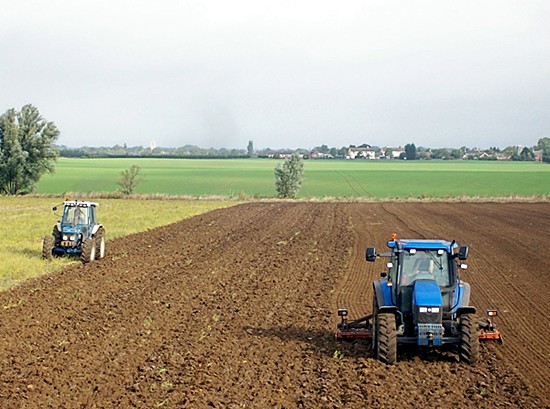 |
|
 |
|
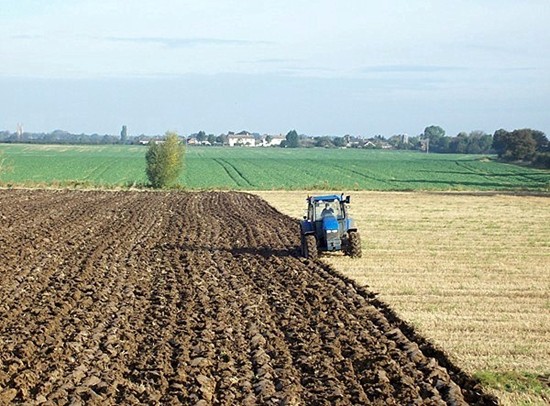 |
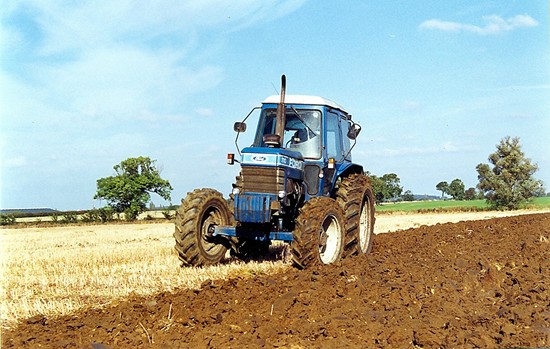 |
|
The most familiar farming sight is ploughing, the
annual turning of the upper layer of soil to bring fresh nutrients to the
surface while burying weeds and the remains of previous crops and allowing
them to break down. Here a four furrow reversible plough can be seen at
work in the autumn on a fifty acre stubble field between the north of
Bourne and Dyke village. |
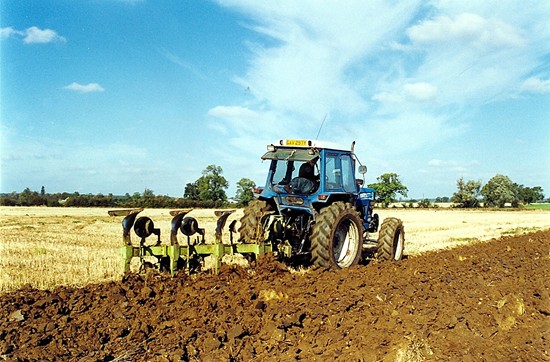 |
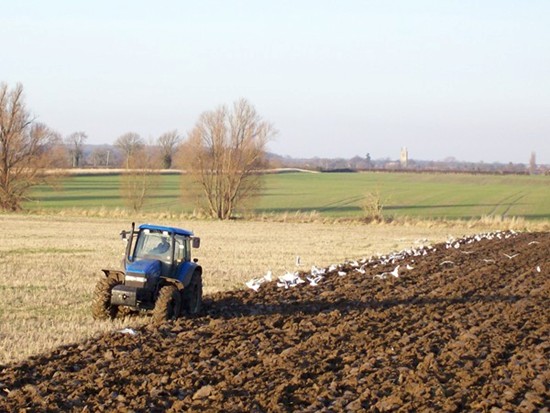 |
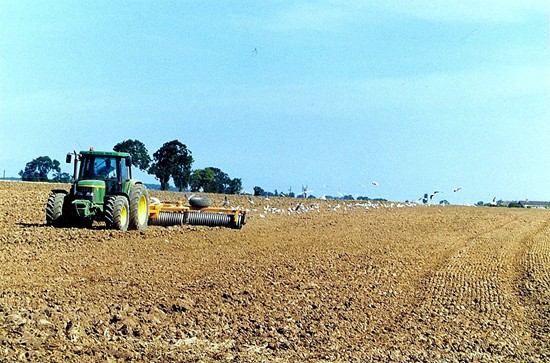 |
|
After the harvest comes the ploughing followed by harrowing and
rolling, each operation accompanied by flocks of seagulls that quickly
congregate to feed on the grubs and worms thrown up in the freshly turned
soil such as here between the north of Bourne and Dyke village, even
though the sea is well over twenty miles away. |

Go to:
Main Index Villages
Index
|








